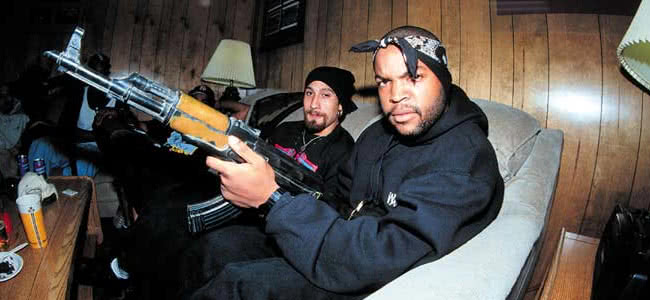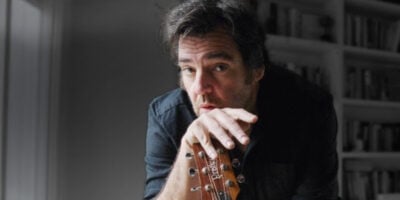An unidentified individual has released a confession that details a secret conspiracy linking the rise of gangster rap in the nineties with the profiteering of major labels and their involvement with privatised prisons.
The confession originally surfaced in the form of an anonymous email via the rap blog, Hip Hop Is Dead, and further filtered to a number of websites. The author of the letter, remaining undisclosed for his personal protection, claims he took part in a confidential assembly in “early 1991″ where the anonymous author was ” invited to attend a closed door meeting with a small group of music business insiders to discuss rap music’s new direction.
“Little did I know that we would be asked to participate in one of the most unethical and destructive business practices I’ve ever seen.” In essence he claims the implementation of a plot designed to glorify rap music to an impressionable consumer market, that would lead to a rise in crime, filling privatised prisons that the labels had investments in.
All that the whistle-blowing scribe lets on is that “between the late 80′s and early 90’s, I was what you may call a “decision maker” with one of the more established companies in the music industry… held at a private residence on the outskirts of Los Angeles” involving “about 25 to 30” music industry professionals.
The nameless author goes on to describe in vague detail a conference headed by “a man who only introduced himself by first name and gave no further details about his personal background.” Continuing to report:
“He briefly praised all of us for the success we had achieved in our industry and congratulated us for being selected as part of this small group of ‘decision makers’… The subject quickly changed as the speaker went on to tell us that the respective companies we represented had invested in a very profitable industry which could become even more rewarding with our active involvement. He explained that the companies we work for had invested millions into the building of privately owned prisons and that our positions of influence in the music industry would actually impact the profitability of these investments.”
“Sure enough, someone asked what these prisons were and what any of this had to do with us. We were told that these prisons were built by privately owned companies who received funding from the government based on the number of inmates. The more inmates, the more money the government would pay these prisons. It was also made clear to us that since these prisons are privately owned, as they become publicly traded, we’d be able to buy shares.”
“He told us that since our employers had become silent investors in this prison business, it was now in their interest to make sure that these prisons remained filled. Our job would be to help make this happen by marketing music which promotes criminal behavior, rap being the music of choice.”
There’s some striking coincidences between the anonymous whistle-blower’s confession and the similarities in geography and timing. 1991 saw the rise of what we now know as ‘gangsta rap,’ originally flourishing as a response between the rivalry between East and West Coast rappers, more specifically it was Los Angeles’ answer to New York’s hardcore hip-hop scene.
Though artists such as Ice-T and Schooly D, and most notably N.W.A.’s 1988 classic Straight Outta Compton, helped pioneer the sub-genre in the late eighties, it wasn’t until acts like Dr. Dre, Snoop Dogg, 2Pac and Cypress Hill emerged in the early nineties that it began to dominate popular music – with the backing of major labels like Columbia, Interscope and Suge Knight’s infamous Death Row, behind them.
The unidentified account is devoid of specifics, or in the writer’s own words, “I have struggled for a long time weighing the pros and cons of making this story public as I was reluctant to implicate the individuals who were present that day. So I’ve simply decided to leave out names and all the details that may risk my personal well being and that of those who were, like me, dragged into something they weren’t ready for.”
The mysterious author calls the plot to get more inmates into the record labels’ privatised prisons as “one of the biggest turning points in popular music, and ultimately American society.” Noting the immediate effects of the events of his meeting he recalls:
“Rap acts that talked about politics or harmless fun were quickly fading away as gangster rap started dominating the airwaves. Only a few months had passed since the meeting but I suspect that the ideas presented that day had been successfully implemented. It was as if the order has been given to all major label executives.”
“The music was climbing the charts and most companies when more than happy to capitalize on it. Each one was churning out their very own gangster rap acts on an assembly line. Everyone bought into it, consumers included. Violence and drug use became a central theme in most rap music. I spoke to a few of my peers in the industry to get their opinions on the new trend but was told repeatedly that it was all about supply and demand.”
“As the years passed, I managed to keep my secret, fearful of sharing it with the wrong person but also a little ashamed of not having had the balls to blow the whistle. But as rap got worse, my guilt grew. Fortunately, in the late 90’s, having the internet as a resource which wasn’t at my disposal in the early days made it easier for me to investigate what is now labeled the prison industrial complex. Now that I have a greater understanding of how private prisons operate, things make much more sense than they ever have. I see how the criminalization of rap music played a big part in promoting racial stereotypes and misguided so many impressionable young minds into adopting these glorified criminal behaviors which often lead to incarceration.”
Indeed, by the end of the decade, rap had become America’s top-selling music genre with over 81 million in sales, which, if the conspiracy theory is to be believed meant a lot more inmates, and a lot more money for the silent partners involved in their private incarceration.
Noting that he’d “officially quit the music business in 1993” and having “broke ties with the majority of my peers and remove myself,” the letter finishes with a personal appeal that attempts to explain his two-decade silence, “Twenty years of guilt is a heavy load to carry but the least I can do now is to share my story, hoping that fans of rap music realize how they’ve been used for the past 2 decades.”
“Although I plan on remaining anonymous for obvious reasons, my goal now is to get this information out to as many people as possible. Please help me spread the word. Hopefully, others who attended the meeting back in 1991 will be inspired by this and tell their own stories. Most importantly, if only one life has been touched by my story, I pray it makes the weight of my guilt a little more tolerable.”
With just enough details in a timeline that checks out, combined with a juicy idea that captures the imagination of any discerning music fan, reading the full account almost conveys a ‘so crazy it might be true’ mentality. Of course, like all good conspiracy theories, it throws up a number of questions. Where’s the evidence? Who was involved? What about the history of the genre? Do a handful of people in a secret meeting really decide the fate of an entire genre’s influence for the next decade?
The overriding question hovering in the air is that of fact or fiction? Could this conspiracy theory be the unfounded rants of someone with a racist agenda and too much time on their hands? or is the first prying of the lid on one of the music industry’s dirtiest and best-kept plots?

































